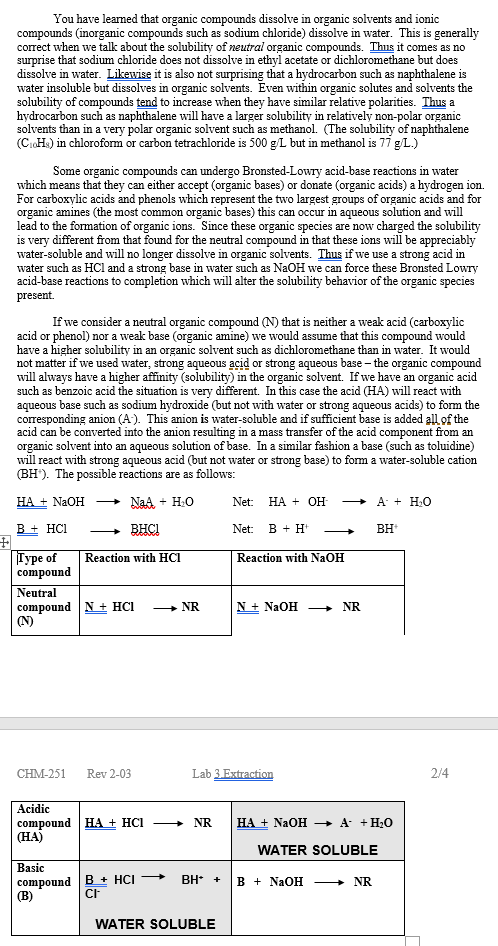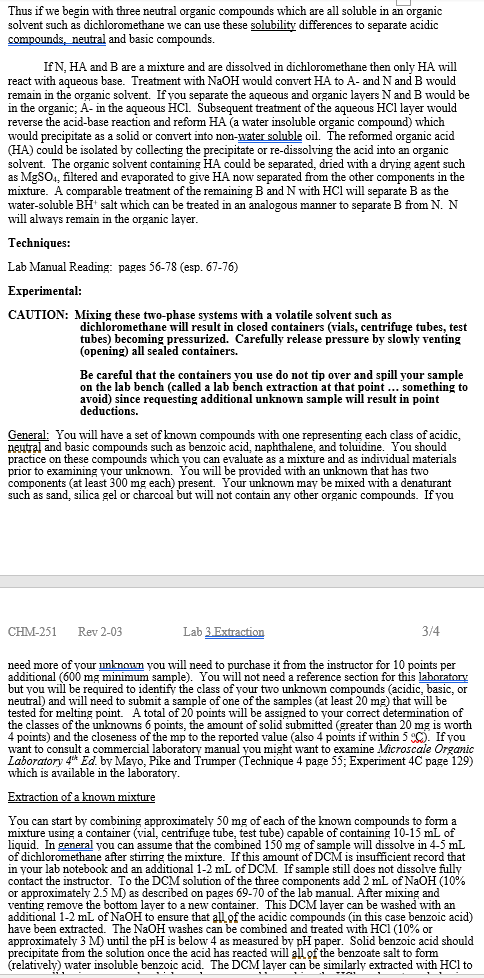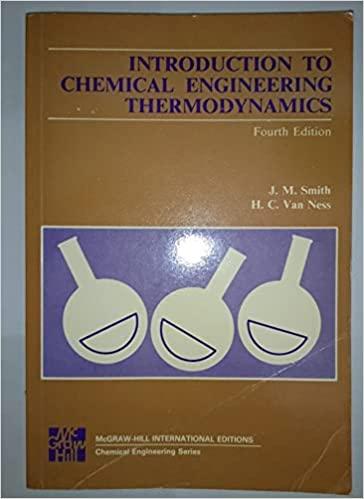Suppose you forget which layer is which, and evaporate both the aqueous layer and the DCM layer. Both leave behind a residue of white solid. How can you tell which one is which?
Suppose you forget which layer is which, but don't want to waste the time evaporating aqueous solutions (good choice!). How could you determine which layer was which without having to isolate the solids?


You have learned that organic compounds dissolve in organic solvents and ionic compounds (inorganic compounds such as sodium chloride) dissolve in water. This is generally correct when we talk about the solubility of neutral organic compounds. Thus it comes as no surprise that sodium chloride does not dissolve in ethyl acetate or dichloromethane but does dissolve in water. Likewise it is also not surprising that a hydrocarbon such as naphthalene is water insoluble but dissolves in organic solvents. Even within organic solutes and solvents the solubility of compounds tend to increase when they have similar relative polarities. Thus a hydrocarbon such as naphthalene will have a larger solubility in relatively non-polar organic solvents than in a very polar organic solvent such as methanol. (The solubility of naphthalene (CH) in chloroform or carbon tetrachloride is 500 g L but in methanol is 77 g L.) Some organic compounds can undergo Bronsted-Lowry acid-base reactions in water which means that they can either accept (organic bases) or donate (organic acids) a hydrogen ion. For carboxylic acids and phenols which represent the two largest groups of organic acids and for organic amines (the most common organic bases) this can occur in aqueous solution and will lead to the formation of organic ions. Since these organic species are now charged the solubility is very different from that found for the neutral compound in that these ions will be appreciably water-soluble and will no longer dissolve in organic solvents. Thus if we use a strong acid in water such as HCl and a strong base in water such as NaOH we can force these Bronsted Lowry acid-base reactions to completion which will alter the solubility behavior of the organic species present. If we consider a neutral organic compound (N) that is neither a weak acid (carboxylic acid or phenol) nor a weak base (organic amine) we would assume that this compound would have a higher solubility in an organic solvent such as dichloromethane than in water. It would not matter if we used water, strong aqueous acid or strong aqueous base - the organic compound will always have a higher affinity (solubility) in the organic solvent. If we have an organic acid such as benzoic acid the situation is very different. In this case the acid (HA) will react with aqueous base such as sodium hydroxide (but not with water or strong aqueous acids) to form the corresponding anion (A). This anion is water-soluble and if sufficient base is added all of the acid can be converted into the anion resulting in a mass transfer of the acid component from an organic solvent into an aqueous solution of base. In a similar fashion a base (such as toluidine) will react with strong aqueous acid (but not water or strong base) to form a water-soluble cation (BH'). The possible reactions are as follows: Net: HA + OH A + HO Net: B + H BH HA + NaOH Naa + H2O B + HCI BHCI Type of Reaction with HCI compound Neutral compound N + HCI NR (N) Reaction with NaOH N + NaOH NR CHM-251 Rev 2-03 Lab 3 Extraction 2/4 Acidic compound HA + HCI (HA) NR HA + NaOH = A + H2O WATER SOLUBLE Basic compound B + HCI (B) CI BH* + B + NaOH + NR WATER SOLUBLE Thus if we begin with three neutral organic compounds which are all soluble in an organic solvent such as dichloromethane we can use these solubility differences to separate acidic compounds, neutral and basic compounds. If N, HA and B are a mixture and are dissolved in dichloromethane then only HA will react with aqueous base. Treatment with NaOH would convert HA to A- and N and B would remain in the organic solvent. If you separate the aqueous and organic layers N and B would be in the organic; A- in the aqueous HCI. Subsequent treatment of the aqueous HCl layer would reverse the acid-base reaction and reform HA (a water insoluble organic compound) which would precipitate as a solid or convert into non-water soluble oil. The reformed organic acid (HA) could be isolated by collecting the precipitate or re-dissolving the acid into an organic solvent. The organic solvent containing HA could be separated, dried with a drying agent such as MgSO4, filtered and evaporated to give HA now separated from the other components in the mixture. A comparable treatment of the remaining B and N with HCl will separate B as the water-soluble BH' salt which can be treated in an analogous manner separate B from N. N will always remain in the organic layer. Techniques: Lab Manual Reading: pages 56-78 (esp. 67-76) Experimental: CAUTION: Mixing these two-phase systems with a volatile solvent such as dichloromethane will result in closed containers (vials, centrifuge tubes, test tubes) becoming pressurized. Carefully release pressure by slowly venting (opening) all sealed containers. Be careful that the containers you use do not tip over and spill your sample on the lab bench (called a lab bench extraction at that point ... something to avoid) since requesting additional unknown sample will result in point deductions. General: You will have a set of known compounds with one representing each class of acidic, neutral and basic compounds such as benzoic acid, naphthalene, and toluidine. You should practice on these compounds which you can evaluate as a mixture and as individual materials prior to examining your unknown. You will be provided with an unknown that has two components (at least 300 mg each) present. Your unknown may be mixed with a denaturant such as sand, silica gel or charcoal but will not contain any other organic compounds. If you CHM-251 Rev 2-03 Lab 3 Extraction 3/4 need more of your unknown you will need to purchase it from the instructor for 10 points per additional (600 mg minimum sample). You will not need a reference section for this laboratory but you will be required to identify the class of your two unknown compounds (acidic, basic, or neutral) and will need to submit a sample of one of the samples (at least 20 mg) that will be tested for melting point. A total of 20 points will be assigned to your correct determination of the classes of the unknowns 6 points, the amount of solid submitted (greater than 20 mg is worth 4 points) and the closeness of the mp to the reported value (also 4 points if within 50). If you want to consult a commercial laboratory manual you might want to examine Microscale Organic Laboratory 4** Ed. by Mayo, Pike and Trumper (Technique 4 page 55; Experiment 4C page 129) which is available in the laboratory. Extraction of a known mixture You can start combining approximately 50 mg of each of the known compounds to fom a mixture using a container (vial, centrifuge tube test tube) capable of containing 10-15 mL of liquid. In general you can assume that the combined 150 mg of sample will dissolve in 4-5 mL of dichloromethane after stirring the mixture. If this amount of DCM is insufficient record that in your lab notebook and an additional 1-2 mL of DCM. If sample still does not dissolve fully contact the instructor. To the DCM solution of the three components add 2 mL of NaOH (10% or approximately 2.5 M) as described on pages 69-70 of the lab manual. After mixing and venting remove the bottom layer to a new container. This DCM layer can be washed with an additional 1-2 mL of NaOH to ensure that all of the acidic compounds (in this case benzoic acid) have been extracted. The NaOH washes can be combined and treated with HCI (10% or approximately 3 M) until the pH is below 4 as measured by pH paper. Solid benzoic acid should precipitate from the solution once the acid has reacted will all of the benzoate salt to form (relatively) water insoluble benzoic acid. The DCM layer can be similarly extracted with HCl to








